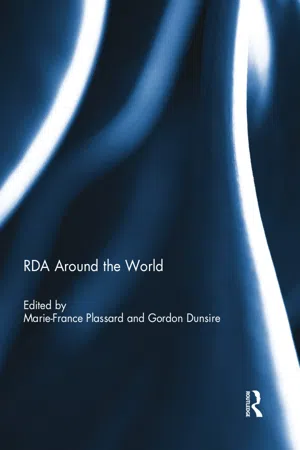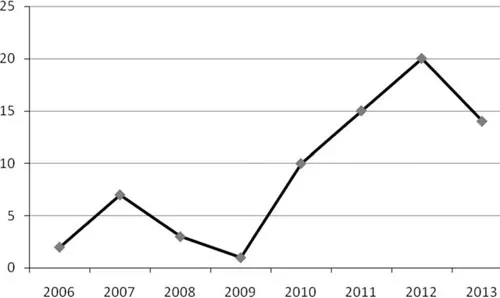![]()
Introduction
GORDON DUNSIRE
Independent Consultant, Edinburgh, Scotland
It has been a great honor to assist with the preparation of this special issue of Cataloging & Classification Quarterly. The excellent articles gathered here cover many topics, the different stages of implementation of Research Description and Access (RDA), and most welcome of all, a wide range of countries and languages around the world. We start with China and travel west to end up in Australia; a circumnavigation of the globe. There are many more countries engaged in translating and implementing RDA than are represented in the articles, which must in any case be regarded as snapshots of continuous and ongoing processes. Yet much of the information contained will be relevant for many years to come, for those who are intending to implement RDA, review the quality of their legacy data, measure the impact of the globalization of cataloging, or prepare for education and orientation in international standards.
Two themes are immediately apparent: translations and training. Both emphasize the international environment of digital, networked information. In the linguistic context RDA’s accommodation for multi-lingual and multi-script data is an attractive feature, but issues soon appear when RDA’s English terminology is translated, such as gender forms and other cases where there is no simple one-to-one correspondence between words. Questions from expert translators can result in a review of the English text to ensure it is as clear as possible. Such feedback is essential for the development of RDA as a global standard. Training in RDA is supported by an international network of resources made available on open access from national and other libraries that have already implemented RDA, along with inspired individuals whose efforts reach out to thousands of librarians around the world. The articles describe the importance of training, not just to learn the RDA terminology and how to apply the instructions, but also to understand and assimilate the principles behind RDA and in particular the user-orientation of Functional Requirements for Bibliographic Records (FRBR) and Functional Requirements for Authority Data (FRAD).
These, and the International Cataloguing Principles, which also influence RDA, are maintained by the International Federation of Library Associations and Institutions (IFLA). This international basis for RDA is clearly a significant factor in the decision to implement RDA; indeed, several articles describe RDA as an opportunity to apply an international, rather than national, standard in their countries. A shift in point of view, from internationalizing a local standard to localizing an international standard, is also evident. This is a challenge for RDA: it must regard its Anglo-American roots as a local view of a much bigger global picture.
Many articles point out the lack of RDA-ready systems for cataloging or information retrieval, and the need to apply RDA within MARC-based infrastructure. A stage of implementation with hybrid catalog records based on legacy rules partially converted to RDA and mixed with born-RDA data seems to be a practical necessity for most libraries adopting RDA. This situation exposes another shift of focus, from “records” to data, echoing the change of wording in the titles of FRBR and FRAD. Several articles give valuable statistics and qualitative information on the transformation of legacy metadata into RDA data. The development of software to meet this task is a pre-cursor to what will be required to interoperate RDA data with linked data from other library communities, related cultural heritage communities such as archives and museums, and ultimately the whole Semantic Web.
For me, what stands out most of all from these papers is the enthusiasm for RDA. Librarians are right to be concerned about costs of implementation, lack of systems, and the apparent redundancy of their expert knowledge of the local catalog and its users, but history tells us that costs are usually justified by eventual benefits, systems for information management and retrieval are part of a rapidly-evolving ecosystem, and catalogs and catalogers have to respond to their users’ expectations. The archive, library, and museum of humankind is in everyone’s hand. The catalog is acting locally; using RDA is thinking globally. The information environment is international, and RDA is the global standard enabling discovery of content.
![]()
China’s Road to RDA
CHONG LUO, DANDAN ZHAO, and DONGFENG QI
National Library of China, Beijing, China
With its brand-new structure and stated advantages, Resource Description and Access (RDA) is intended to be the new international standard of cataloging in the digital world. The Chinese library community has been devoted to analyzing RDA and discussing its implementation. This article introduces the current status of RDA studies in China including achievements of RDA research in recent years and China’s attitudes toward RDA’s implementation. This article also analyzes challenges for RDA’s launch in China and provides suggestions for its localization in China.
INTRODUCTION
Resource Description and Access (RDA), the new international standard developed in accordance with changes in the cataloging environment, is intended to serve as the universal standard for resource description and access in the digital world. Based on the Statement of International Cataloguing Principles (ICP), the conceptual models of Functional Requirements for Bibliographic Records (FRBR) and Functional Requirements for Authority Data (FRAD), and intended as the successor to the Anglo-American Cataloguing Rules, Second Edition (AACR2), RDA provides a comprehensive set of guidelines and instructions on resource description and access covering all types of content and media. Although confronted with doubts and controversies in the process of its development, RDA has drawn great attention among the international library community due to its stated advantages, such as extensibility, consistency, flexibility, and high efficiency.
The Committee of Principals (CoP) is responsible for all policies and programs related to RDA, such as the publication of revisions and new editions, and so on. The Joint Steering Committee for Development of RDA (JSC) is authorized by the CoP with responsibility for updating and maintaining the content of RDA. The constituent organizations represented on the JSC are from the United States, Great Britain, Canada, Australia, and Germany. One of the stated goals of RDA is to become a standard that is “… able to be used in other language communities.”1 Thus, since the beginning of its development, non-English-speaking countries have paid close attention to RDA.
In Europe, where the traditions of cataloging are different from Anglo-American traditions, countries such as Germany have also been following the development of RDA. Presently German and French versions of RDA have been updated in the RDA Toolkit, and the Spanish version is underway. In Asia, South Korea completed the Korean version in 2009, and started to revise the KORMARC format for the use of RDA. In Arab countries a conference, Cataloging Rules in the 21st Century, was held in Cairo in 2013. Aimed at getting the Arabic library community involved in the international cataloging community, the conference discussed significant issues related to RDA and challenges that faced the Arab library community. The RDA Arabic Group was established to take charge of coordinating RDA implementation in the Arabic library community.
The Chinese cataloging community has always paid attention to the development of RDA, and research on RDA is steadily on the increase, especially after its official release. As more and more countries begin to implement RDA or carry out RDA testing, the focus of RDA research in the Chinese cataloging community has been extended and specified, shifting from theory to practice.
STUDY AND PRACTICE IN CHINA
RDA has drawn attention from Chinese scholars and librarians ever since its development. The achievements of study and practice in recent years can be categorized into the following: research papers, projects, RDA Chinese translation version, training and seminars, survey, and attempts at RDA implementation.
Research Papers
On searching the main Chinese e-journal databases, including China Academic Journal Network Publishing Database, Vip Journal Integration Platform, and Wanfang Data,2 we found 72 articles had dealt with RDA by September 2013. The number of papers studying RDA in China has increased from 2 in 2006 to 20 in 2012. The detailed number for each year is shown in Figure 1.
FIGURE 1 Journal Articles of RDA Study in China from 2006 to 2013.
As shown by the figures, research papers on RDA have the following characteristics. Firstly, RDA study had a rather late start in China. The development of RDA was initiated at the International Conference on the Principles and Future Development of AACR held by JSC in 1997. Yet before 2006 there were few studies on RDA and even in 2006 the number of research papers was only 2. There was only one paper on RDA in 2009, which indicates the wait-and-see attitude at that time. Secondly, RDA study has grown rapidly in recent years, especially after the publication of RDA in 2010. The number of research papers is increasing dramatically, with a total of 20 in 2012. Thirdly, Chinese scholars focus on various aspects of RDA including the basics of RDA, RDA’s applied research, comparative study of RDA and the Chinese Cataloging Rules, and RDA’s localization.
• Basics of RDA. The basics of RDA cover RDA’s background, history of development, foundation, structure, content, features and relationship with other international cataloging standards such as AACR2 and International Standard for Bibliographic Description (ISBD).345 In terms of the number of papers, studies of RDA basics are the highest. Of the 72 papers on RDA published from 2006 to 2013, about 1/3 (24 papers) introduce RDA. The other papers also involve a more or less relative fundamental knowledge. These papers help librarians to gain a better understanding of RDA.
• Applied research of RDA. The purpose of developing RDA is for cataloging practice. Applied research of RDA includes changes of rules from AACR2R to RDA, the design and usage of the RDA Toolkit, the update of MARC 21 for use with RDA, methods to create RDA records for books, serials and e-resources as well as RDA and linked data, and so on.678910 There are 19 papers on this theme, which accounts for 1/3 of all RDA papers.
• Comparative study of RDA and Chinese Cataloging Rules. The differences between RDA and the Chinese Cataloging Rules are possible obstacles that may block the adoption of RDA in China, hence comparative studies between the two codes attract the attention of Chinese scholars and librarians. Seven papers compare the organization, development, and structure of the two sets of rules, including similarities and differences between specific entries.11
• RDA localization. Whether RDA will be adopted in China is what most concerns the Chinese library community. Eleven papers analyze the condition of the Chinese cataloging environment and address the prospects of RDA in China.12–13 The authors not only express their concerns about RDA’s localization, but also give helpful advice on how to implement RDA in China.
RDA Research Projects
Besides research papers, research projects on RDA are ongoing with the support of the National Social Science Fund, the National Library of China (NLC), and institutions of higher learning:
• National Social Science Fund Project. In 2011, the National Social Science Fund supported a project named Research on Localization and Adoption of Resource Description and Access in China. This project focuses on the adaptability of RDA in the Chinese cataloging environment, and emphasizes both theoretical studies and practice. Based on a comparative study of similarities and differences between RDA and the Chinese Cataloging Rules, it proposes strategies for the adoption of RDA for cataloging Chinese resources. In order to apply to the CNMARC format that is used for cataloging Chinese resources, the project provides mappings between the CNMARC format and RDA, and suggests revision of the CNMARC format to be compatible with RDA. More importantly, the project is attempting to catalog Chinese resources with RDA, design workflows, and propose a vision for cataloging Chinese resources with RDA. This project has come to its concluding phase and will release its reports soon.
• National Library of China Key Project. In 2012, the NLC funded a ...

